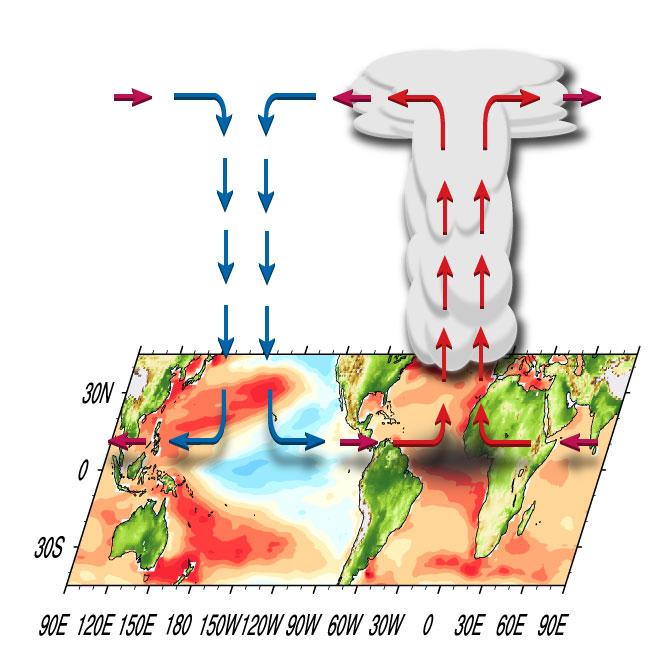Extending climate predictability beyond El Niño

This image shows inter-basin coupling as a cause of multi-year tropical Pacific climate predictability: Impact of Atlantic warming on global atmospheric Walker Circulation (arrows). Rising air over the Atlantic subsides over the equatorial Pacific, causing central Pacific sea surface cooling, which in turn reinforces the large-scale wind anomalies. Credit: Yoshimitsu Chikamoto
At present computer simulations can predict the occurrence of an El Niño event at best three seasons in advance. Climate modeling centers worldwide generate and disseminate these forecasts on an operational basis. Scientists have assumed that the skill and reliability of such tropical climate forecasts drop rapidly for lead times longer than one year.
The new findings of predictable climate variations up to three years in advance are based on a series of hindcast computer modeling experiments, which included observed ocean temperature and salinity data. The results are presented in the April 21, 2015, online issue of Nature Communications.
“We found that, even three to four years after starting the prediction, the model was still tracking the observations well,” says Yoshimitsu Chikamoto at the University of Hawaii at Manoa International Pacific Research Center and lead author of the study. “This implies that central Pacific climate conditions can be predicted over several years ahead.”
“The mechanism is simple,” states co-author Shang-Ping Xie from the University of California San Diego. “Warmer water in the Atlantic heats up the atmosphere. Rising air and increased precipitation drive a large atmospheric circulation cell, which then sinks over the Central Pacific. The relatively dry air feeds surface winds back into the Atlantic and the Indian Ocean. These winds cool the Central Pacific leading to conditions, which are similar to a La Niña Modoki event. The central Pacific cooling then strengthens the global atmospheric circulation anomalies.”
“Our results present a paradigm shift,” explains co-author Axel Timmermann, climate scientist and professor at the University of Hawaii. “Whereas the Pacific was previously considered the main driver of tropical climate variability and the Atlantic and Indian Ocean its slaves, our results document a much more active role for the Atlantic Ocean in determining conditions in the other two ocean basins. The coupling between the oceans is established by a massive reorganization of the atmospheric circulation.”
The impacts of the findings are wide-ranging. “Central Pacific temperature changes have a remote effect on rainfall in California and Australia. Seeing the Atlantic as an important contributor to these rainfall shifts, which happen as far away as Australia, came to us as a great surprise. It highlights the fact that on multi-year timescales we have to view climate variability in a global perspective, rather than through a basin-wide lens,” says Jing-Jia Luo, co-author of the study and climate scientist at the Bureau of Meteorology in Australia.
“Our study fills the gap between the well-established seasonal predictions and internationally ongoing decadal forecasting efforts. We anticipate that the main results will soon be corroborated by other climate computer models,” concludes co-author Masahide Kimoto from the University of Tokyo, Japan.
###
Citation: Chikamoto, Y., A. Timmermann, J.-J. Luo, T. Mochizuki, M. Kimoto, M. Watanabe, M. Ishii, S.-P. Xie, and F.-F. Jin: Skilful multi-year predictions of tropical trans-basin climate variability. Nature Communications, 6:6869, doi: 10.1038/ncomms7869 (2015).
Funding:
This study was supported by the Japanese Ministry of Education, Culture, Sports, Science and Technology, through the Program for Risk Information on Climate Change. The simulations were performed with the Earth Simulator at the Japan Agency for Marine-Earth Science and Technology and the NEC SX-8R at the National Institute for Environmental Studies. A. T. and Y. C. were supported by NSF (1049219); S.P. Xie by NSF and NOAA.
Author contacts:
Yoshimitsu Chikamoto International Pacific Research Center, School of Ocean and Earth Science and Technology, University of Hawaii at Manoa, Honolulu, Hawaii 96822; email: chika44@hawaii.edu; phone: (808) 956-9054.
Axel Timmermann, Professor of Oceanography, International Pacific Research Center, School of Ocean and Earth Science and Technology, University of Hawaii at Manoa, Honolulu, Hawaii 96822; email: axel@hawaii.edu; phone: (808) 956-2720.
Fei-Fei Jin, Professor Department of Meteorology, School of Ocean and Earth Science and Technology, University of Hawaii at Manoa, Honolulu, Hawaii 96822; email: jff@hawaii.edu; phone: (808) 956-4645.
International Pacific Research Center Media Contact:
Gisela E. Speidel, International Pacific Research Center, School of Ocean and Earth Science and Technology, University of Hawaii at Manoa, Honolulu, Hawaii 96822; email: gspeidel@hawaii.edu; phone (808) 956-9252.
Media Contact
Gisela Speidel
gspeidel@hawaii.edu
808-956-9252
Media Contact
All latest news from the category: Earth Sciences
Earth Sciences (also referred to as Geosciences), which deals with basic issues surrounding our planet, plays a vital role in the area of energy and raw materials supply.
Earth Sciences comprises subjects such as geology, geography, geological informatics, paleontology, mineralogy, petrography, crystallography, geophysics, geodesy, glaciology, cartography, photogrammetry, meteorology and seismology, early-warning systems, earthquake research and polar research.
Newest articles

Silicon Carbide Innovation Alliance to drive industrial-scale semiconductor work
Known for its ability to withstand extreme environments and high voltages, silicon carbide (SiC) is a semiconducting material made up of silicon and carbon atoms arranged into crystals that is…

New SPECT/CT technique shows impressive biomarker identification
…offers increased access for prostate cancer patients. A novel SPECT/CT acquisition method can accurately detect radiopharmaceutical biodistribution in a convenient manner for prostate cancer patients, opening the door for more…

How 3D printers can give robots a soft touch
Soft skin coverings and touch sensors have emerged as a promising feature for robots that are both safer and more intuitive for human interaction, but they are expensive and difficult…




















